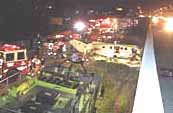 ATERRIZAJE DE EMERGENCIA DEL YV- 2466
P
ATERRIZAJE DE EMERGENCIA DEL YV- 2466
P 

El día miércoles 13 de junio de 2001, en horas de la noche aterrizo de emergencia el YV- 2466 P , BEECHCRAFT BE-90 KING AIR, serial: LJ - 0591, año 1973, color blanco con franjas azules y doradas, dicha aeronave procedía del Aeropuerto Caracas, Charallave, Estado Miranda, Venezuela, con destino el aeropuerto de Fort Lauderdale, Florida, USA, con tres tripulantes.
El piloto se reporto en emergencia por problemas técnicos en uno de sus motores, realizando un aterrizaje de emergencia en la autopista I- 95 en cercanías de Fort Lauderdale.

El piloto cuando salía de la avioneta YV- 2466P
Resultaron heridos sus ocupantes que fueron rescatados por la Unidad BROWARD COUNTRY FIRE RESCUE y trasladados al Centro Médico HOLLYWOOD MEMORIAL REGIONAL HOSPITAL, donde ingresaron en estado critico el piloto y un pasajero.
El
piloto fue identificado como JOSÉ SANTIAGO
NÚÑEZ GÓMEZ (53 años), cedula de identidad
V - 3.176.075, propietario de la aeronave, y dos pasajeros identificados
como CELESTINO ALBERTO MARTÍNEZ MACHADO (+)
y BRICEIDA DEL VALLE ZAPATA GAMBOA (34 años), la avioneta
descolo de aeropuerto Caracas a las 19:17 UTC (15:17 HLV).
HORA DEL ACCIDENTE 09:25 P.M. HORA LOCAL MIAMI.
Alrededor de las 9:25 p.m. hora local Miami, el avión Beechcraft - 90 King Air, con tres personas a bordo, se estrelló contra un muro de retención en la rampa de salida hacia el sur de Griffin Road, dijo Todd LeDuc, de la Brigada de Bomberos del Condado Broward. ``Es un milagro que esquivaran los autos'', dijo LeDuc. ``Me parece un milagro que sólo muriera una persona''.
A las 11:55 p.m., los socorristas recuperaron el cuerpo de un hombre, identificado como Celestino Alberto Martínez Machado, de 34 años y original de Venezuela, del asiento derecho al frente de la avioneta.
José Santiago Nuñez Gómez, el piloto de 53 años, y Briceida del valle Zapata Gamboa, de 34 años, ambos venezolanos, fueron transportados al Memorial Regional Hospital en Hollywood en condición crítica con miembros fracturados, según autoridades de rescate y del hospital.
Ambos
estaban conscientes y alerta cuando llegaron al hospital, según un
agente de los Bomberos de Dania Beach.
"Dios ha tenido de acompañar a ese avión esta noche porque debía haberse pulverizado en un millón de pedazos'', dijo Jim Reeder de Biscayne Park, quien estaba lavando su auto cerca del lugar. ``Es un milagro que alguien haya salido vivo de ahí''.
Agentes dijeron que la rampa de salida permanecería cerrada hasta que los restos del fuselaje fueran retirados, lo que probablemente afectaría al tráfico matinal en su hora pico.
Nota: Celestino Alberto Martínez Machado fue sepultado en el día domingo 17 de junio de 2001 en horas de la mañana en el cementerio La Guairita, Caracas, Venezuela.
INFORMACIÓN PRELIMINAR DEL CASO YV - 2466 P
Accident occurred Wednesday, June 13, 2001 at Fort Lauderdale, FL, USA.
Aircraft:Beech C-90, registration: YV2466P
Injuries:
1 Fatal, 2 Serious.
This is preliminary information, subject to change, and may contain errors.
Any errors in this report will be corrected when the final report has been
completed.
On June 13, 2001, about 2122 eastern daylight time, a Beech C-90, YV-2466P, Venezuelan registered to a private individual, operating as a Title 14 CFR Part 91 personal flight, crashed while on final approach to Fort Lauderdale-Hollywood International Airport, (FLL) Florida. Night visual meteorological conditions prevailed and an instrument flight plan had been filed. The aircraft was destroyed, a foreign pilot-rated passenger in the right pilot's seat was fatally injured, and the left seated foreign pilot was seriously injured, as was a passenger in the cabin. The flight originated from Caracus, Venezuela's Oscar Machado Zuloaga Airport, at 1517 eastern daylight time.
According to the FLL tower controller who was directing the aircraft for landing, the flight was routinely handed off to his position from Miami Approach Control radar for a visual landing. When YV-2466P made his initial radio call to FLL tower at 2117, he was given the following instructions, " YV-2466P, you are number one for [runway] 9R, winds are 140 at 7, cross the shoreline at one thousand", [feet-altitude, msl]. At 2120, the tower controller transmitted, "2466P cleared to land." At 2121, the pilot of YV-2366P transmitted in sequence, "I need the field, I have difficulties here...small problem with engine." The controller transmitted, "wind check, 140 at 8, no need to acknowledge", and estimated YV-2466P was 500 feet agl, and 3/4 mile from the threshold to runway 9R with landing lights illuminated, when he momentarily directed his attention to an airline jet rolling out on the north runway. When he redirected his attention to runway 9R, he could not see his lights.
The aircraft's first contact with the terrain was near the centerline of an off-ramp road that runs parallel to north-south oriented highway Interstate 95 (I-95), on its west side. The wreckage path was perpendicular to I-95 , was 33 feet in length, and terminated at a 15-foot vertical concrete wall that elevates I-95. Scars on the road and wreckage analysis reveal the landing gear hit the road first hard, collapsed the three landing gear, and bent the empennage and both wing outer panels downward before impacting the wall. The wall bore distinct imprints of the nose and both propeller spinners. Preliminary examination of the fuel system revealed total fuel found in the tanks to be minimal. Fuel found in the fuel lines and fuel filter housings of both engines totalled less than a pint.